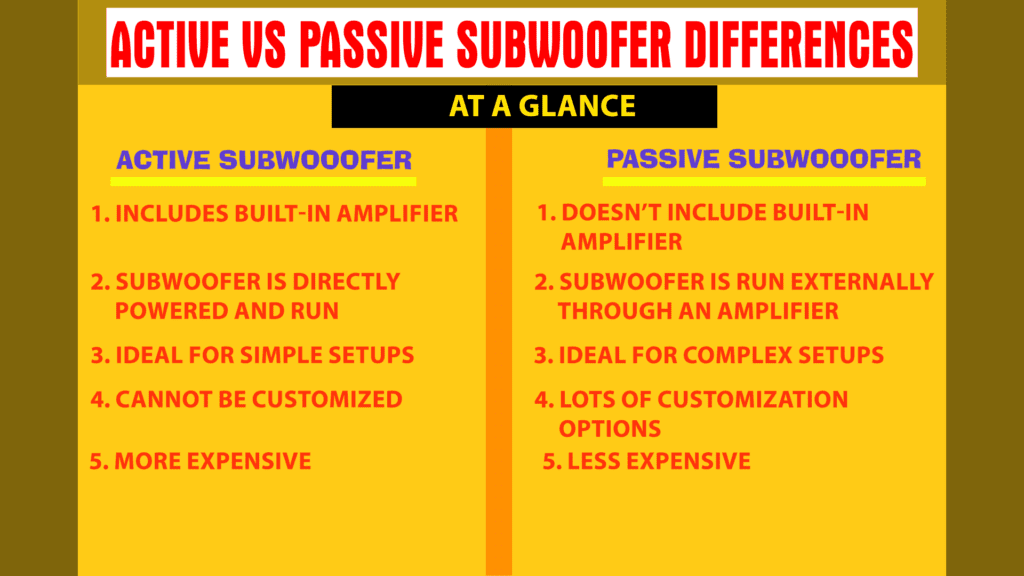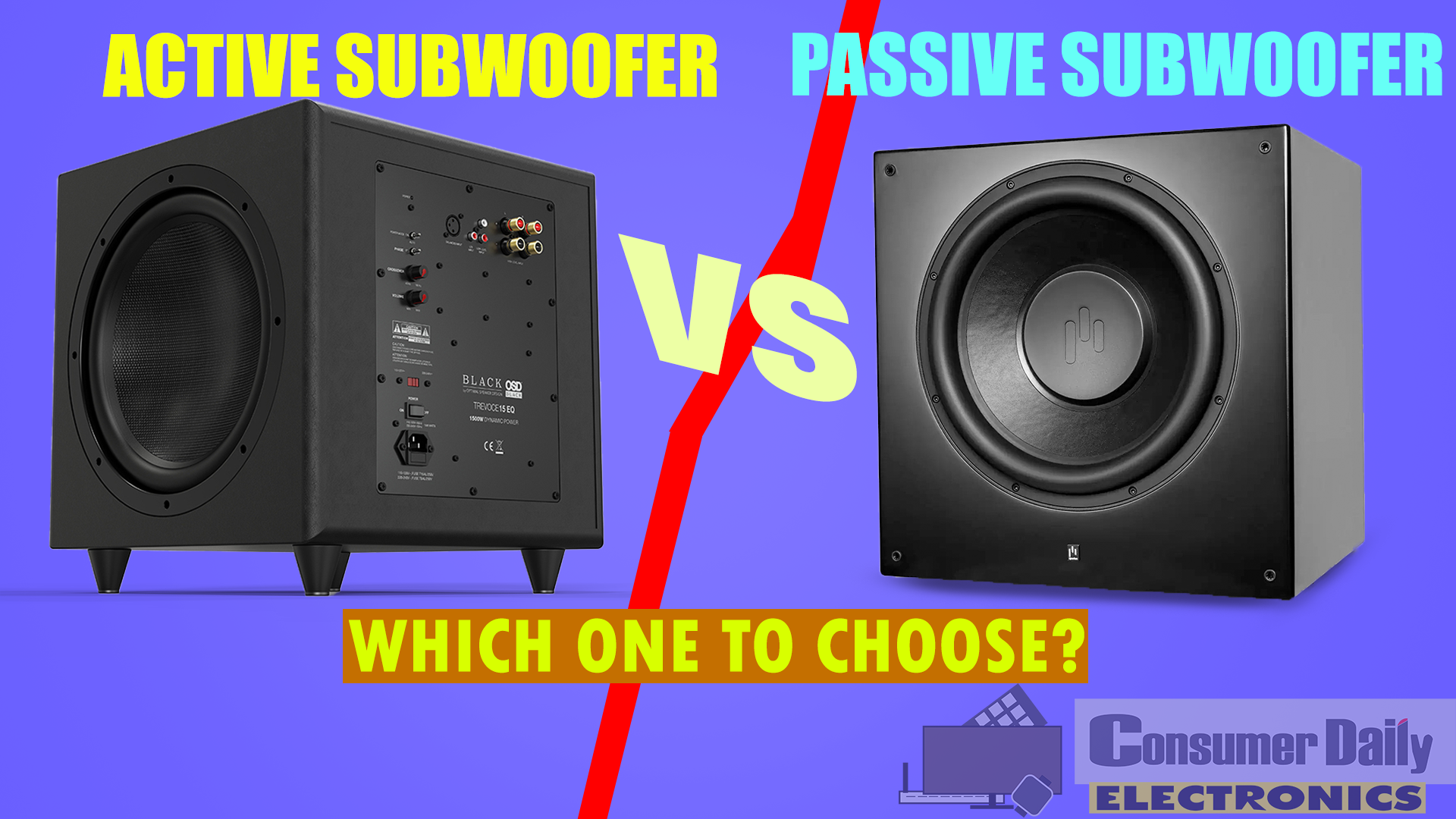Introduction to Subwoofers
What is a Subwoofer?
Subwoofers are specialized speakers which are designed to reproduce low-frequency audio, often referred to as bass. These frequencies are crucial for enhancing music, movies, and other audio experiences, delivering a deep and immersive sound that standard speakers often cannot achieve. Think of that chest-thumping rumble during an action scene in a movie or the resonating beats of a live concert—you can thank subwoofers for that.
Subwoofers are usually of two types: active and passive subwoofer. This article will mainly describe the comparison: active vs passive subwoofers.
The Role of Subwoofers in a Sound System
A subwoofer bridges the gap between high and low frequencies in your sound system. Without it, your audio might sound flat or lack depth. Whether you’re a music enthusiast or a movie buff, a subwoofer ensures you experience the richness and intensity of sound in its full spectrum.
Why Understanding the Difference Matters
Active and passive subwoofers serve the same purpose but operate differently. Choosing the wrong type for your setup can lead to underwhelming performance or compatibility issues. By understanding their distinctions, you’ll make an informed decision that suits your audio needs.
Overview of Active and Passive Subwoofers
What is an Active Subwoofer?
An active subwoofer, also known as a powered subwoofer, comes with a built-in amplifier. This means it can independently power itself without relying on an external amplifier. All you need is a power source and a connection to your audio system. These subwoofers are plug-and-play, making them user-friendly and highly convenient for home theaters or compact setups.
What is a Passive Subwoofer?
Passive subwoofers, on the other hand, require an external amplifier or receiver to operate. Think of it as part of a larger sound system, where the amplifier sends power to the subwoofer. While they are less straightforward than active subwoofers, they offer flexibility in terms of customization and integration into professional setups.
Key Differences Between Active and Passive Subwoofers

Power Source
Active subwoofers have built-in amplifiers, eliminating the need for external equipment. Passive subwoofers rely entirely on an external amplifier or receiver to function.
Setup and Installation
Active subwoofers are easier to set up, requiring fewer connections. In contrast, passive subwoofers demand more technical knowledge, as you’ll need to match the amplifier’s power output with the subwoofer’s requirements.
Sound Quality and Performance
While both types can deliver excellent sound quality, active subwoofers are often pre-tuned by manufacturers for optimal performance. Passive subwoofers allow for more customization, which may appeal to audiophiles seeking precision.
Cost and Affordability
Passive subwoofers are generally more affordable but require additional investment in an external amplifier. Active subwoofers, while pricier upfront, don’t need external components, which can save you money in the long run.
Portability and Space Requirements
Active subwoofers are self-contained and portable, ideal for smaller spaces. Passive subwoofers, being part of a larger system, may require more space for both the subwoofer and amplifier.
Pros and Cons of Active Subwoofers
Video Comparison
Here’s a video comparison between active and passive subwoofers:
Advantages of Active Subwoofers
- Ease of Use: They’re plug-and-play, making them accessible for beginners.
- Compact Design: The built-in amplifier saves space and eliminates the need for extra components.
- Consistency: Manufacturers optimize them for balanced performance.
Disadvantages of Active Subwoofers
- Higher Cost: They’re typically more expensive than passive subwoofers.
- Limited Customization: You’re reliant on the manufacturer’s settings.
Pros and Cons of Passive Subwoofers
Advantages of Passive Subwoofers
- Flexibility: Allows you to customize and upgrade components for better sound.
- Cost-Effective: Initial cost is lower compared to active subwoofers.
Disadvantages of Passive Subwoofers
- Complex Setup: Requires careful matching with an external amplifier.
- Less Portable: Often part of larger sound systems, making them harder to move.
Use Cases and Applications
When to Use an Active Subwoofer
Active subwoofers are perfect for home theaters, gaming setups, and casual listening. Their simplicity makes them ideal for users who prioritize convenience.
When to Use a Passive Subwoofer
Passive subwoofers are better suited for professional audio setups, outdoor sound systems, or users who want complete control over their sound system’s customization.
Compatibility with Audio Systems
Active Subwoofers and Modern Home Theaters
Modern home theaters often favor active subwoofers due to their simplicity and ability to integrate seamlessly with receivers and soundbars.
Passive Subwoofers and Custom Setups
Audiophiles and professionals lean toward passive subwoofers, as they allow for intricate setups tailored to specific acoustic preferences.
Tips for Choosing the Right Subwoofer
Assess Your Audio Needs
Identify whether you need a subwoofer for casual listening or professional use.
Budget Considerations
Determine how much you’re willing to spend, keeping in mind potential additional costs for passive subwoofers.
Room Size and Acoustic Properties
Smaller rooms may benefit more from active subwoofers, while larger spaces can accommodate the customization of passive subwoofers.
Popular Brands for Active and Passive Subwoofers
Top Active Subwoofer Brands
Top Passive Subwoofer Brands
Conclusion: Choosing the Right Subwoofer for Your Needs
The decision between an active and passive subwoofer boils down to your specific needs, budget, and technical expertise. Active subwoofers offer convenience and portability, while passive subwoofers provide customization and flexibility. By weighing the pros and cons, you can confidently choose the right choice between active and passive subwoofers that elevates your audio experience.
FAQs About Active and Passive Subwoofers
1. Can I use a passive subwoofer without an amplifier?
No, passive subwoofers require an external amplifier to function.
2.Are active subwoofers better for small rooms?
Yes, their compact design and easy setup make them ideal for smaller spaces.
3. Can I upgrade an active subwoofer’s built-in amplifier?
No, active subwoofers come with fixed amplifiers that cannot be upgraded.
4. Are passive subwoofers more durable?
Durability depends on the brand and model, not necessarily the type of subwoofer.
5. Which type of subwoofer is better for beginners?
Active subwoofers are more beginner-friendly due to their plug-and-play nature.
Related: JBL Clip 4 Review: Attractive Compact Rugged Bluetooth Speaker

